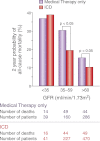CKD and sudden cardiac death: epidemiology, mechanisms, and therapeutic approaches
- PMID: 23100219
- PMCID: PMC3507359
- DOI: 10.1681/ASN.2012010037
CKD and sudden cardiac death: epidemiology, mechanisms, and therapeutic approaches
Abstract
Multiple studies demonstrate a strong independent association between CKD and cardiovascular events including death, heart failure, and myocardial infarction. This review focuses on recent clinical studies that expand this spectrum of adverse cardiovascular events to include ventricular arrhythmias and sudden cardiac death. In addition, experimental models suggest structural remodeling of the heart and electrophysiologic changes in this population. These processes may explain the increased arrhythmic risk in kidney disease and aid in identifying patients who are at higher risk for sudden cardiac death. Finally, we review here the data to support the use of pharmacologic and device-based therapies for both the primary and secondary prevention of sudden cardiac death.
Figures




References
-
- Levey AS, Atkins R, Coresh J, Cohen EP, Collins AJ, Eckardt KU, Nahas ME, Jaber BL, Jadoul M, Levin A, Powe NR, Rossert J, Wheeler DC, Lameire N, Eknoyan G: Chronic kidney disease as a global public health problem: Approaches and initiatives - a position statement from Kidney Disease Improving Global Outcomes. Kidney Int 72: 247–259, 2007 - PubMed
-
- Nissenson AR, Pereira BJ, Collins AJ, Steinberg EP: Prevalence and characteristics of individuals with chronic kidney disease in a large health maintenance organization. Am J Kidney Dis 37: 1177–1183, 2001 - PubMed
-
- Coresh J, Byrd-Holt D, Astor BC, Briggs JP, Eggers PW, Lacher DA, Hostetter TH: Chronic kidney disease awareness, prevalence, and trends among U.S. adults, 1999 to 2000. J Am Soc Nephrol 16: 180–188, 2005 - PubMed
-
- Keith DS, Nichols GA, Gullion CM, Brown JB, Smith DH: Longitudinal follow-up and outcomes among a population with chronic kidney disease in a large managed care organization. Arch Intern Med 164: 659–663, 2004 - PubMed
-
- Foley RN, Parfrey PS, Sarnak MJ: Epidemiology of cardiovascular disease in chronic renal disease. J Am Soc Nephrol 9[Suppl]: S16–S23, 1998 - PubMed
Publication types
MeSH terms
Grants and funding
LinkOut - more resources
Full Text Sources
Other Literature Sources
Medical

